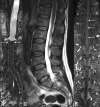Spinal cord ischemia: practical imaging tips, pearls, and pitfalls
- PMID: 25324492
- PMCID: PMC7990611
- DOI: 10.3174/ajnr.A4118
Spinal cord ischemia: practical imaging tips, pearls, and pitfalls
Abstract
Ischemia of the spinal cord is a rare entity with a poor prognosis. Brain ischemia is no longer a diagnostic challenge; on the contrary, ischemia of the spinal cord remains difficult, particularly in children. In this article, we illustrate the principal causes in children and adults, clinical presentation, different techniques for the diagnosis by MR imaging (diffusion, spinal MR angiography, and 1.5 versus 3T), pathophysiology, and differential diagnosis. We will discuss current knowledge, perspectives, and pitfalls.
© 2015 by American Journal of Neuroradiology.
Figures






References
-
- Sandson TA, Friedman JH. Spinal cord infarction: report of 8 cases and review of the literature. Medicine 1989;68:282–92 - PubMed
-
- Piffaretti G, Bonardelli S, Bellosta R, et al. . Spinal cord ischemia after simultaneous and sequential treatment of multilevel aortic disease. J Thorac Cardiovasc Surg 2014;148:1435–42.e1 - PubMed
-
- Gorelik N, Tampieri D. Cocaine-induced vasospasm causing spinal cord transient ischemia. Neuroradiol J 2012;25:364–67 - PubMed
-
- Márquez JC, Granados AM, Castillo M. MRI of cervical spinal cord infarction in a patient with sickle cell disease. Clin Imaging 2012;36:595–98 - PubMed
Publication types
MeSH terms
LinkOut - more resources
Full Text Sources
Other Literature Sources
